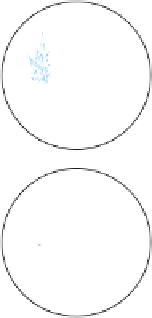Environmental Engineering Reference
In-Depth Information
support 98% of the 250,000 identified species living in
the ocean.
Av erage primary productivity and NPP per unit
of area are quite low in the open sea except at an occa-
sional equatorial upwelling, where currents bring up
nutrients from the ocean bottom. However, because
the open sea covers so much of the earth's surface, it
makes the largest contribution to the earth's overall
NPP.
Natural Capital Degradation
Coral Reefs
Ocean warming
Soil erosion
Algae growth from fertilizer runoff
Mangrove destruction
Effects of Human Activities on Marine
Systems: Red Alert
People are destroying or degrading many of the
coastal areas' most vital resources.
In their desire to live near the coast, people are de-
stroying or degrading the resources that make coastal
areas so enjoyable and economically and ecologically
valuable. Currently, 45% of the world's people and
more than half of the U.S. population live along or
near coasts. Some 13 of the world's 19 megacities with
populations of 10 million or more people are located in
coastal zones. By 2030, at least 6.3 billion people are ex-
pected to live in or near coastal areas. Figure 5-33 lists
major human impacts on marine systems.
Coral reef bleaching
Rising sea levels
Increased UV exposure from ozone
depletion
Using cyanide and dynamite to
harvest coral reef fish
Coral removal for building material,
aquariums, and jewelery
Damage from anchors, ships, and
tourist divers
Figure 5-32
Natural capital degradation:
major threats to
coral reefs.
Critical thinking: which two of these threats do you
believe are the most serious?
Natural Capital Degradation
Marine Ecosystems
Biological Zones in the Open Sea: Light Rules
The open ocean consists of a brightly lit surface
layer, a dimly lit middle layer, and a dark bottom
zone.
The sharp increase in water depth at the edge of the
continental shelf separates the coastal zone from the
vast volume of the ocean called the
open sea.
Primar-
ily on the basis of the penetration of sunlight, it is di-
vided into three vertical zones (see Figure 5-26).
The
euphotic zone
is the brightly lit upper zone
where floating drifting phytoplankton carry out pho-
tosynthesis. Nutrient levels are low (except around
upwellings), and levels of dissolved oxygen are high.
Large, fast-swimming predatory fish such as sword-
fish, sharks, and bluefin tuna populate this zone.
The
bathyal zone
is the dimly lit middle zone that
does not contain photosynthesizing producers because
of a lack of sunlight. Various types of zooplankton and
smaller fish, many of which migrate to feed on the sur-
face at night, populate this zone.
The lowest zone, called the
abyssal zone,
is dark
and very cold and has little dissolved oxygen. Never-
theless, the ocean floor contains enough nutrients to
Half of coastal wetlands lost to
agriculture and urban
development
Over one-third of mangrove
forests lost since 1980 to
agriculture, development, and
aquaculture shrimp farms
About 10% of world's beaches
eroding because of coastal
development and rising sea level
Ocean bottom habitats degraded
by dredging and trawler fishing
boats
At least 20% of coral reefs
severely damaged and 30-50%
more threatened
Figure 5-33
Natural capital degradation:
major human im-
pacts on the world's marine systems.
Critical thinking: how does
your lifestyle directly or indirectly contribute to this degradation?





























































































































































































































































































































































































































































































































































































































































































































































































































































































































































































































































































































































































































